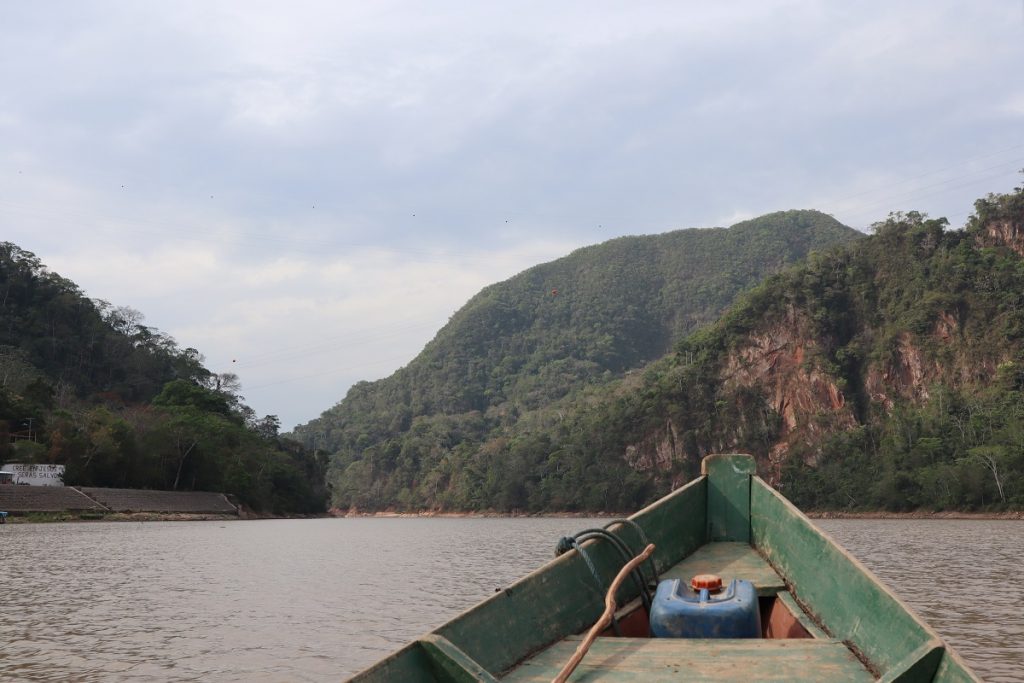This is what the economy of the Amazon…
10 July, 2024
Tuesday 11 january 2022
Photo: © Mariel Cabero, IUCN NL
Under the supervision of Mariel Cabero, Expert Environmental Justice at IUCN NL, eight students of the Environmental Justice course at Wageningen University and Research studied the dam construction project in Bolivia. This article presents their main findings.
Located in one of the most biodiverse areas of the world, the Madidi National Park and Pilon Lajas Biosphere Reserve, the dam construction will become Bolivia’s largest water infrastructure project to date. Government owned energy corporation Empresa Nacional de Electricidad (ENDE) is at the forefront of the construction. They present the project as profitable and in line with environmental regulations, in spite of numerous environmental and socioeconomic concerns raised by local citizens, environmental groups, indigenous people and several NGOs.
Situated relatively close to each other, the construction of the two dams requires over 170,000 hectares of the Amazon to be flooded. The decomposition of forests and flooded biodiversity will cause significant greenhouse gases. Some studies report that “hydroelectric plants in the Amazon produce more greenhouse gases than thermoelectric plants, due to the decomposition of the vegetation in the area[1]Costa A.K.N., Vibian C.F., Cardoso D.E.V. and Guerra S.M.G., “Brasil y sus intereses en la construcción de Cachuela Esperanza, Bolivia”, Polis [Online], 39 | 2014, Online since 06 January 2015, … Continue reading. The magnitude of these mega-dams will be an ecocide for certain species of flora and fauna endemic to the region. Impacts of the dams will not be limited to the flooded area, the dams would also impact upstream and downstream ecosystems[2]Molina Carpio, Jorge & Cortez, Roger & Garcia, Maria & Teijeiro, Jose & Pacheco, Luis. (2019). ANÁLISIS INTEGRAL DEL PROYECTO GUBERNAMENTAL REPRESAS HIDROELÉCTRICAS CHEPETE –BALA.
If the dam construction is being continued, the rights of Mother Earth – as contained in the Bolivian Constitution – would be violated.
In addition to the impact on the area’s biodiversity and ecosystem, the construction would also harm seventeen communities that currently live in the area. This means that more than 5,000 indigenous people will be forced leave their ancestral land, yet these communities are not being heard by the government. In 2015, for example, the project was about to start without adequate Free Prior and Informed Consent. Due to pressure from local communities, it was paused again.

The indigenous peoples have stated they have not had sufficient opportunities to voice their concerns about the project. Ruth Alipaz, a representative of one of the affected indigenous communities, stated in an interview that the government is hiding information on the project from indigenous communities on purpose, such as feasibility and impact evaluation studies.
The communities are currently trying to put a halt to these studies, as they fear the dam construction will start as soon as the studies are finished, regardless of the outcome of the studies.
Profitability studies regarding the dam construction concluded that the dams would not to be economically viable. This raises questions as to why the Bolivian Government wants construction to continue and if Brazil even needs energy imported from Bolivia. Over time, the Bolivian government has developed ties with China, with Import Export Bank of China funding the project and requiring that Bolivia contracts Chinese equipment and companies for construction. For China the dams are economically beneficial, but Geodata Engineering states that the dams should be delayed until market conditions become more advantageous. Nevertheless, in November 2021, government owned ENDE has recently announced that the construction of the dams will be started in the very near future.
An analysis of this case and its stakeholder engagement process found that protests and other types of community responses help the indigenous peoples to achieve more power in the process. Involving local people and allowing them to have a say in the decision-making process would allow the project to be more environmentally just.
International engagement through activists, NGOs and other networks resulting in global awareness about the endangered livelihoods of the indigenous peoples pushes the Bolivian state to consider the views and concerns of the indigenous communities.
Furthermore, proper stakeholder engagement and sufficient global awareness will decrease the chances of indigenous communities being criminalized or falling victim to political repression.
In the midst of an accelerating climate crisis, it is crucial that infrastructure projects follow all standards carefully, and most importantly: prioritize biodiversity and indigenous rights over profit.


| ↑1 | Costa A.K.N., Vibian C.F., Cardoso D.E.V. and Guerra S.M.G., “Brasil y sus intereses en la construcción de Cachuela Esperanza, Bolivia”, Polis [Online], 39 | 2014, Online since 06 January 2015, connection on 11 January 2022. URL: http://journals.openedition.org/polis/10399 |
|---|---|
| ↑2 | Molina Carpio, Jorge & Cortez, Roger & Garcia, Maria & Teijeiro, Jose & Pacheco, Luis. (2019). ANÁLISIS INTEGRAL DEL PROYECTO GUBERNAMENTAL REPRESAS HIDROELÉCTRICAS CHEPETE –BALA |